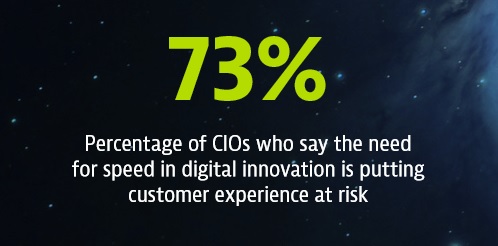
CIOs of 73% of organizations say the need for speed in digital innovation is putting customer experience at risk, according to an independent global survey of 800 CIOs commissioned by Dynatrace.
The study found that on average, organizations release new software updates three times per working hour, as they push to keep up with competitive pressures and soaring consumer expectation.

Looking ahead, 89% of CIOs said they will need to release updates even faster in the future. However, the speed of releases can come at a cost. Nearly two-thirds (64%) of CIOs admitted they are forced to compromise between faster innovation and the need to ensure customers have a great software experience.
“Every organization on the planet is a software company these days. Market leaders like Amazon are releasing multiple software updates every second. Consequently, the modern approach to delivering software is about agile, fast development cycles and releasing into dynamic, hybrid multi-cloud environments,” said Andreas Grabner, DevOps Activist, Dynatrace. “Yet end users also expect the steady flow of new features and updates to work perfectly, without compromise. The challenge for IT is to deliver fast, while moving to a cloud native architecture and maintaining user experience.”
The new CIO report looks at the pains organizations face as they strive for new heights of agility and speed. Key findings include:
Cloud enables agility but CIOs struggle with:
■ Ensuring software performance isn’t negatively impacted (67%)
■ Identifying if moving an application to the cloud has delivered the desired benefits (57%)
■ Understanding if an application is well-suited to the cloud (55%)
■ Re-architecting legacy applications for the cloud (51%)
■ Ensuring the user-experience isn’t impacted during the migration process (48%)
Lack of collaboration and visibility leads to innovation delays:
■ 78% of CIOs said their organization has experienced IT project delays that could have been prevented if development and operations teams were able to easily collaborate
■ CIOs said digital transformation initiatives were most frequently derailed by:
- IT outages caused by external issues (55%)
- IT outages caused by internal changes (50%)
- Rectifying bad code that has been pushed through the pipeline (45%)
Organizations face challenges as they turn to DevOps to improve collaboration:
■ 68% of organizations have implemented or are exploring the possibilities of a DevOps culture to improve collaboration and drive faster innovation
■ 74% of CIOs said that DevOps efforts are often being undermined by the absence of shared data and tools, which makes it difficult for IT teams to obtain a single view of "the truth"
■ 56% of CIOs identified differences in priorities between departmental siloes as an additional barrier to DevOps adoption
“The challenge for all organizations is to get a holistic view of the DevOps pipeline – from idea to code to experience. As DevOps has matured, enterprises are looking to automate and integrate their software development to release faster, with higher quality, and with less manual effort. It’s exciting to see AI play an even greater role in reducing manual tasks, so we can do what we love – write better software, deploy with speed, and deliver perfect software experiences,” adds Grabner.
About the Survey: This report, commissioned by Dynatrace, is based on a global survey of 800 CIOs in large enterprises with over 1,000 employees, conducted by Vanson Bourne and commissioned by Dynatrace. The sample included 200 respondents in the US, 100 in the UK, France, Germany and China, and 50 in Australia, Singapore, Brazil and Mexico respectively.


